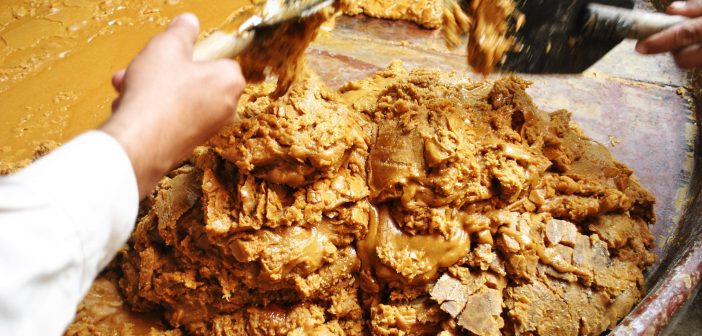Jaggery, a non-centrifugal cane sugar, forms the heart of countless Indian sweet treats. But among them, Gur ka Pyaar (or Gur ki Pak) holds a special place. This simple yet delectable dessert, with its rich, earthy flavor and melt-in-your-mouth texture, has captivated taste buds across generations. Let’s embark on a journey to explore the origins, variations, and cultural significance of this beloved Indian sweet.
A Legacy Rooted in Tradition: The Origins of Gur ka Pyaar
The precise origin of Gur ka Pyaar remains shrouded in the mists of time, but its connection to jaggery points towards a long and storied history. Jaggery production in India dates back millennia, with evidence suggesting its use as early as the Indus Valley Civilization (3300-1300 BCE) [Insert Link to Indus Valley Civilization and jaggery production]. Over the centuries, jaggery became a staple sweetener across the subcontinent, finding its way into countless culinary creations. Gur ka Pyaar likely emerged from this rich tradition, a simple dessert reflecting the resourcefulness and ingenuity of Indian kitchens.
Beyond Sugar: The Ingredients and Variations
At its core, Gur ka Pyaar boasts a minimalist list of ingredients: ghee (clarified butter), gram flour, and jaggery. Ghee’s rich, nutty flavor forms the base, while gram flour provides a delightful texture and slight nuttiness. Jaggery lends its signature sweetness and earthy notes, creating a symphony of flavors in every bite. However, this seemingly basic recipe allows for regional variations.
In North India, particularly in Uttar Pradesh and Rajasthan, Gur ka Pyaar is often denser and richer. Here, a higher proportion of gram flour is used, resulting in a slightly chewy texture. The South Indian version, particularly popular in Karnataka and Tamil Nadu, tends to be lighter and flakier. Here, roasted semolina (sooji) may be added for a unique textural contrast. Spices like cardamom and nuts like cashews can be incorporated for additional flavor and visual appeal.
A Symbol of Celebration: Gur ka Pyaar in Indian Culture
Gur ka Pyaar transcends its deliciousness to hold a significant place in Indian culture. Its association with jaggery, a natural and unrefined sweetener, resonates with the Ayurvedic principles of healthy living. The sweet’s rich flavor and simple preparation make it a popular offering during festivals and auspicious occasions. Diwali, the festival of lights, sees households prepare Gur ka Pyaar as part of the festive spread. Weddings and other celebrations often feature this sweet as a symbol of prosperity and happiness.
The Art of Making Gur ka Pyaar: A Culinary Journey
Creating Gur ka Pyaar requires patience and a keen eye. Ghee is first heated until it reaches a golden hue, followed by the addition of the gram flour. Roasting the flour is crucial, as it releases its nutty aroma and enhances the texture. Jaggery is then melted in a separate pan, and the two mixtures are combined with careful stirring to ensure a smooth consistency. The mixture is then poured onto a greased plate and allowed to cool. Once set, it’s cut into desired shapes, ready to be savored.
A Modern Twist: Reimagining Gur ka Pyaar for Today’s Palate
While Gur ka Pyaar retains its traditional charm, modern culinary innovations are offering exciting twists on this classic sweet. Some chefs are experimenting with flavored gkees, infusing them with saffron or cardamom for a more nuanced experience. Others are using different types of flours, like almond or oat flour, to cater to dietary preferences. These creative interpretations demonstrate the adaptability of Gur ka Pyaar, ensuring its continued relevance in today’s culinary landscape.
A Bite of History, A Taste of Tradition: The Enduring Allure of Gur ka Pyaar
Gur ka Pyaar represents more than just a sweet treat; it’s a window into India’s rich culinary heritage. Its connection to jaggery, its simplicity, and its cultural significance make it a treasured part of the Indian culinary identity. So, on your next visit to India, don’t miss the opportunity to indulge in this delectable dessert. With every bite, you’ll experience a confluence of flavors, tradition, and the enduring love for sweets that defines Indian cuisine.






